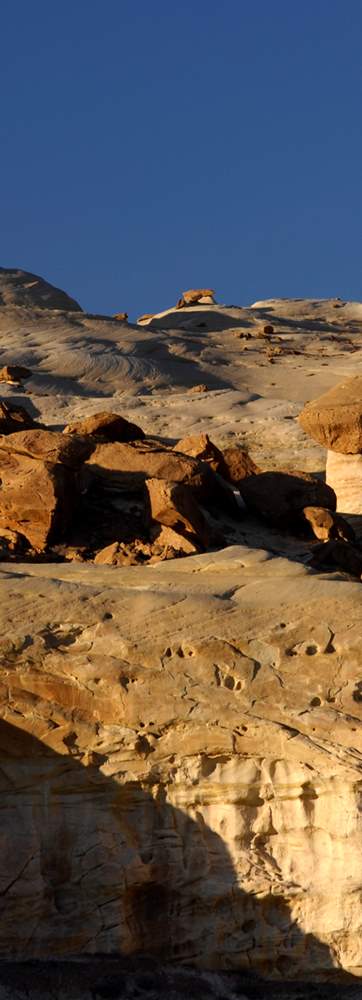
Grand Staircase
Location
South-central Utah, north and west of the Glen Canyon National Recreation Area and Lake Powell. Grand Staircase is the westernmost section of the monument and is most easily accessed from Tropic, Cannonville or Henrieville near Kodachrome Basin State Park on Highway 12–also known as Scenic Byway 12– and Kanab or Big Water on U.S. Route 89. Travelers can easily combine trips to Lake Powell via the Wahweap Marina with a stop at the Big Water Visitor Center, known for its fascinating exhibits of the park's rich paleontological record.
Geography and Geology
The aptly named “Grand Staircase” marches northward from the North Rim of the Grand Canyon to the 9,000-foot edge of Utah’s High Plateaus. The colorful succession of “risers” in the staircase include, from south to north, the Shinarump Cliffs, the Vermilion Cliffs, the White Cliffs, the Gray Cliffs, and the Pink Cliffs. Progressively higher terraces separate each cliff band.
The Paria River is the principal drainage of the Grand Staircase region, coursing 80 miles from Utah’s High Plateaus to its confluence with the Colorado River at Lees Ferry. The Paria River carves the deepest canyon in the region through the Paria Plateau. It approaches 3,000 feet deep in places. Paria Canyon is also one of the region’s longest backcountry journeys. Stretching nearly 40 miles from White House Trailhead to the canyon’s mouth at Lees Ferry on the Colorado River, the trail meanders through canyons renowned for their narrow slots and is a popular attraction for hikers.
Visitor Centers and Entrances
This area has no official entrances, but several visitor centers surround the monument(s). The main Grand Staircase visitor center is the Kanab Visitor Center. The center offers excellent interpretive displays and staff members to answer your questions. Smaller visitor centers are at the Paria Contact Station, Big Water and Cannonville. Big Water is known for its fascinating exhibits of the park's rich paleontological record.
Where To Stay
Overnight Options: To the southwest, Kanab offers the greatest selection of hotels, motels, and lodges, but there are hotel and motel options in other small towns around the monument. Whitehouse Campground is an established campground near Kanab. Additional camping opportunities can be found at Kodachrome Basin State Park, Escalante Petrified Forest State Park, and other established grounds on the northeast side. Primitive camping is also allowed in the monument (try to use established areas).
Nearest groceries and supplies: Various small towns surround the monument. Kanab and Bryce Canyon City are good options for supplies near the monument.Climate and Weather
Visitors come to the Grand Staircase region year-round, but most come during spring and autumn. Since the region is a desert environment, with daytime high temperatures often reaching 95 to 105 degrees Fahrenheit almost daily from June through August, summer is the most unfavorable time of the year to hike in and visit the area.
Spring weather (March through May) can be highly variable, with daytime high temperatures ranging from the 50s to the 70s and nighttime lows ranging from 20 to 50 degrees. Occasional cold fronts from the west and northwest can bring cold, windy conditions, rain showers in the lower elevations, and perhaps snow on the higher mesas, particularly in March and April. Generally warm, dry weather prevails between storm systems.
Autumn provides some of the most stable weather of the year. Clear, warm, sunny days and cool nights make this one of the most delightful seasons to visit the Grand Staircase-Esalante region. Expect daytime highs to range from the 70s and 80s in September to the 40s and 50s by November. Overnight lows typically range from 20 to 50 degrees.
Winter in the Grand Staircase-Escalante region is cold and often windy. The ground above 6,000 feet is often covered with inches of snow, and deep snow may render some high-elevation areas inaccessible between December and mid-March each year.
When to Visit
The monument is open 24 hours a day year-round. Check visitor center hours online.
Fees and Permits
Entrance is free. Overnight permits are required for car camping and backpacking. Stop in at a visitor center for a permit (also available at some established trailheads and campgrounds).
